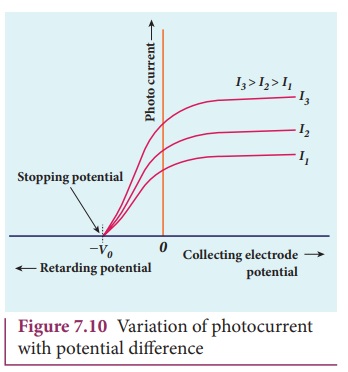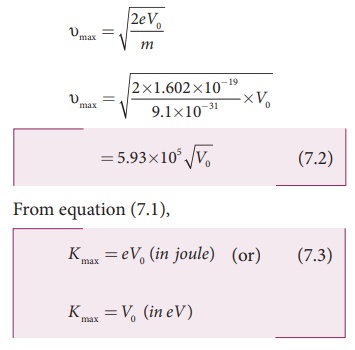Photo Electric Effect | Physics - Effect of potential difference on photoelectric current | 12th Physics : UNIT 8 : Dual Nature of Radiation and Matter
Chapter: 12th Physics : UNIT 8 : Dual Nature of Radiation and Matter
Effect of potential difference on photoelectric current
Effect of potential difference on photoelectric
current
To study the effect of potential
difference V between the electrodes
on photoelectric current, the frequency and intensity of the incident light are
kept constant. Initially the potential of A
is kept positive with respect to C and
the cathode is irradiated with the given light.
Now, the potential of A is increased and the corresponding
photocurrent is noted. As the potential of A
is increased, photocurrent is also increased. However a stage is reached
where photocurrent reaches a saturation value (saturation current) at which all
the photoelectrons from C are collected
by A. This is represented by the flat portion of
the graph between potential of A and
photocurrent (Figure 7.10).
When a negative (retarding) potential
is applied to A with respect to C, the current does not immediately drop
to zero because the photoelectrons are emitted with some definite and different
kinetic energies. The kinetic energy of some of the photoelectrons is such that
they could overcome the retarding electric field and reach the electrode A.
When the negative (retarding) potential
of A is gradually increased, the
photocurrent starts to decrease because more and more photoelectrons are being
repelled away from reaching the electrode A. The photocurrent becomes zero at a
particular negative potential V0,
called stopping or cut-off potential.

Stopping potential is that the value
of the negative (retarding) potential given to the collecting electrode A which is just sufficient to stop the
most energetic photoelectrons emitted and make the photocurrent zero.
At the stopping potential, even the
most energetic electron is brought to rest. Therefore, the initial kinetic
energy of the fastest electron (Kmax)
is equal to the work done by the stopping potential
to stop it (eV0).

where Žģmax is the maximum speed of the emitted photoelectron.
= 5.93├Ś105 ŌłÜV0 (7.2)

From equation (7.1),
Kmax = eV0 (in joule) (or) (7.3)
Kmax = V0 (in eV )
From the Figure 7.10, when the
intensity of the incident light alone is increased, the saturation current also
increases but the value of V0
remains constant.
Thus, for a given frequency of the
incident light, the stopping potential is independent of intensity of the
incident light. This also implies that the
maximum kinetic energy of the photoelectrons is independent of intensity of the
incident light.
Related Topics